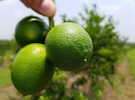The coronavirus crisis is affecting Mexico's lemon sector.  According to Bernardo Bravo, the president of the National Committee for the Lemon Product System of Mexico AC (CONASIPROLIM): “The market is difficult and complicated. Demand has fallen in restaurants and bars, and we have a slow flow in sales. Only certain profiles, which go for good prices, are being sold and they are being sold to department stores and fruit shops that deliver the products to homes. Sales, in some cases, are minimal, and in others they have increased; things are fluctuating a lot."
According to Bernardo Bravo, the president of the National Committee for the Lemon Product System of Mexico AC (CONASIPROLIM): “The market is difficult and complicated. Demand has fallen in restaurants and bars, and we have a slow flow in sales. Only certain profiles, which go for good prices, are being sold and they are being sold to department stores and fruit shops that deliver the products to homes. Sales, in some cases, are minimal, and in others they have increased; things are fluctuating a lot."
Sector challenges
According to Bernardo Bravo (in the image), “global phytosanitary alerts regarding citrus are increasingly latent and present in a large part of the citrus areas of this country.  Without a doubt, pests and diseases can cause a severe crisis for producers to the point that growing citrus could stop being a profitable activity.”
Without a doubt, pests and diseases can cause a severe crisis for producers to the point that growing citrus could stop being a profitable activity.”
“Commercial issues in free competition may lead to keeping prices below the cost of production within the markets. The so-called sales at a loss are a reality in this country and, when there is a constant offer without demand, the members of the chain can face unpleasant situations,” he stated.
Insecurity
“The insecurity we experience in the main lemon production regions in Mexico has become a constant that doesn't allow moving safely within them or having the conditions so that producers can work with the tranquility they deserve,” he said.
"The market for our lemons is eminently national. No country in the world consumes more lemon than Mexico and our product is very well positioned among the Mexican people thanks to its quality, flavor, and distinction over any other variety," stated Bernardo Bravo. "We'll export nearly 15% of our production to international markets."
Sector needs
The main needs of the sector, according to Bernardo Bravo, include improving production costs and having greater disclosure and the presence of advertising campaigns in the United States. “The Hispanic market knows our variety, but it seems that it is ceasing to consume it. More information and training are also needed to comply with global safety standards in a practical and producer-friendly sense,” he added.
The future of Mexican lemons
"The future of Mexican lemons is headed toward the professionalization of the field, we have one of the largest production areas in this country where everything, all the irrigation, is entirely mechanized. We have technical equipment to maintain healthy trees and fruits, we have committed producers willing to maintain their way of life to generate an economic spill over to the most vulnerable sectors of each producing region,” he added.
"But we are also afraid of having an excessive oversupply, and the presence of more and more pests and diseases, which may leave many families producing this citrus in total bankruptcy," the head of CONASIPROLIM concluded.
More than 1,500,000 tons of lemons
The production of lemons of the Mexican variety exceeds one and a half million tons per year and is carried out in more than 90,000 hectares distributed in the four states with the highest production: Michoacan, Colima, Oaxaca, and Guerrero.
Mexico produces Mexican lemon (Citrus x Aurantifolia), Persian lime (Citrus x Latifolia), and Italian lemon (Citrus x Lemon), among other varieties. The first two varieties are available all year round. The Italian lemon is still cultivated on a small surface and is handled more seasonally, with a presence in the winter season.
Written by Francisco Seva Rivadulla, food journalist
